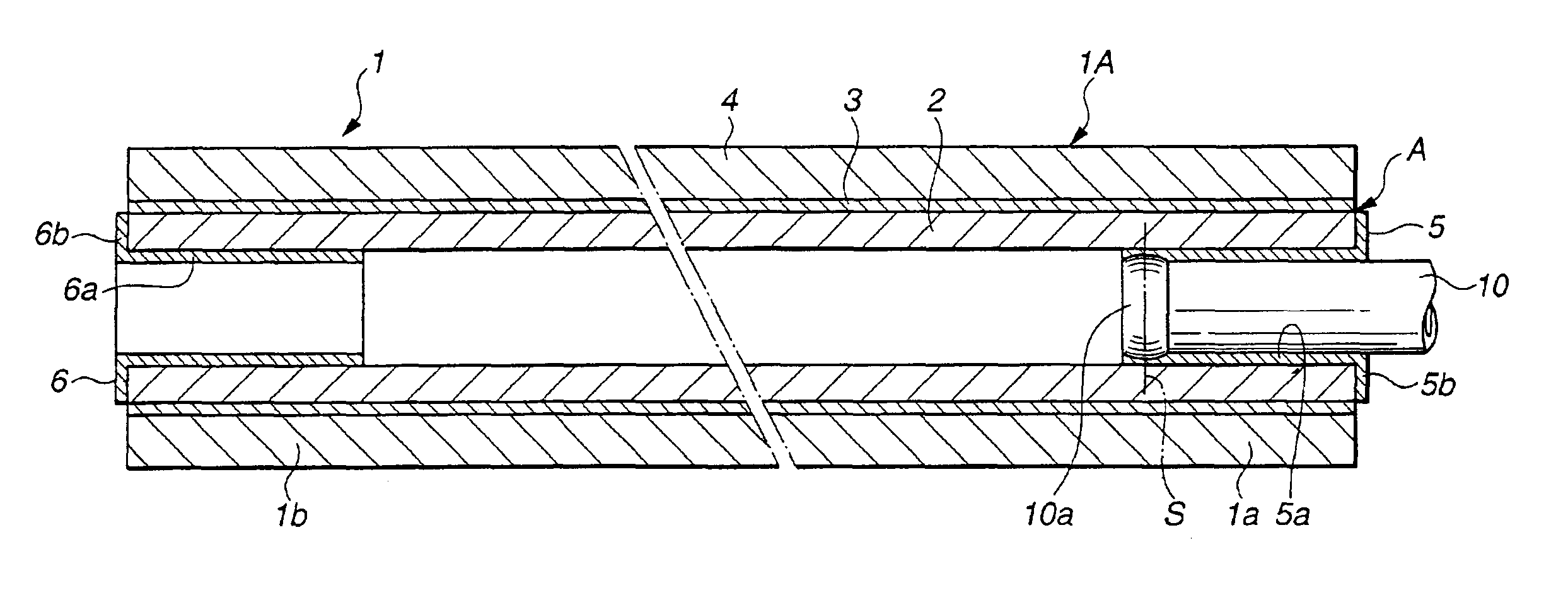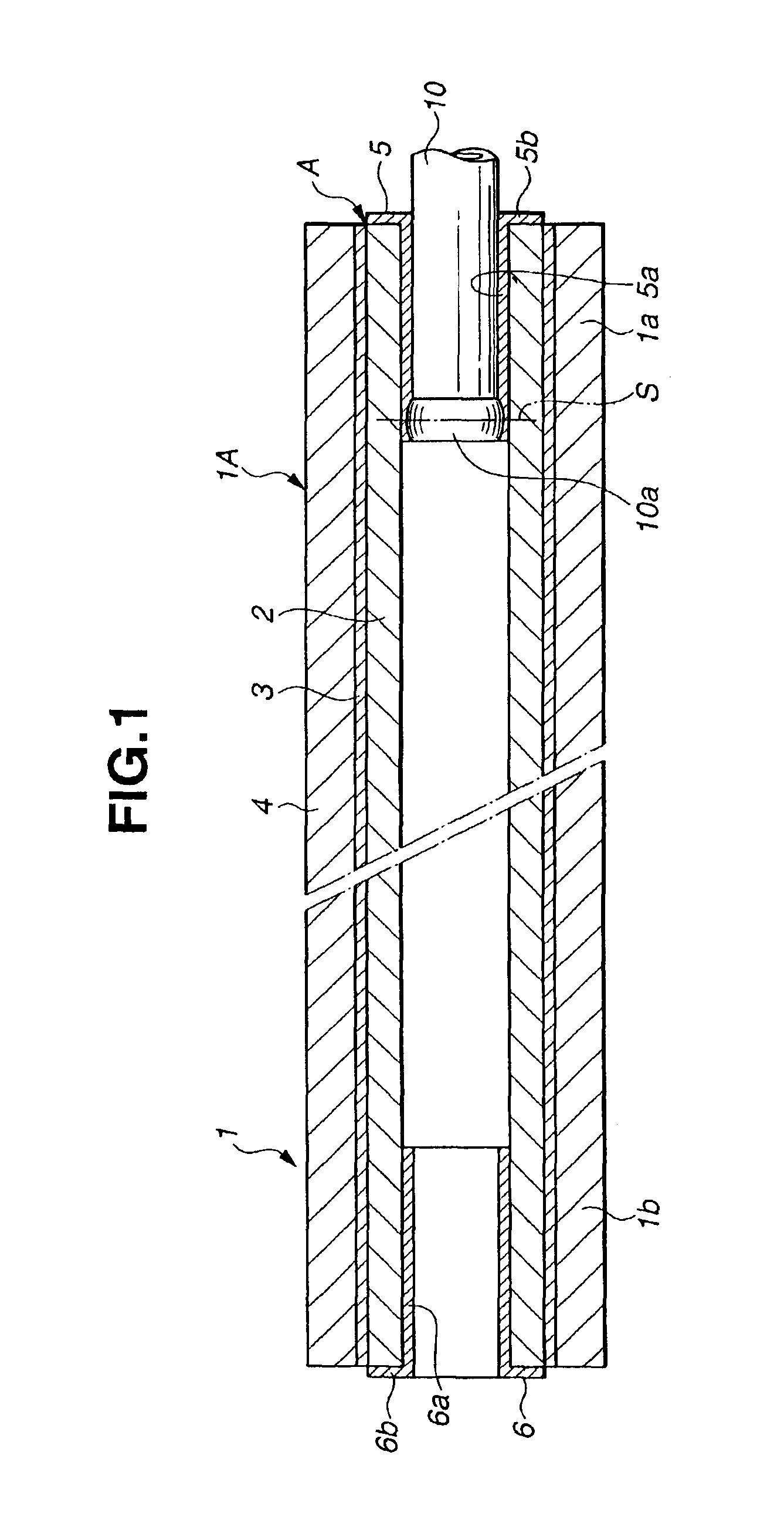Fuel hose and producing method therefor
a technology of fuel hoses and hoses, which is applied in the direction of other domestic products, synthetic resin layered products, chemical processes, etc., can solve the problem that the longitudinal direction of the innermost layer cannot be blocked particularly at the end section, and achieve the effect of low fuel permeability and high fuel permeability
- Summary
- Abstract
- Description
- Claims
- Application Information
AI Technical Summary
Benefits of technology
Problems solved by technology
Method used
Image
Examples
example 1
[0032]Amine-based primer was coated at the opposite end regions of the inner peripheral surface of hose main body 1A and the opposite end faces of hose main body 1A, followed by drying. Each end region extended from the end face to a longitudinal position of 30 mm from the end face. The primer-coated surface of hose main body 1A was then coated with a solution which had been prepared by dissolving 15% by weight of powder of tetrafluoroethylene-hexafluoropropylene-vinylidene fluoride copolymer (“THV 220” produced by DYNEON) in methylethyl ketone (MEK). Then, the coated surface of hose main body 1A was subjected to drying at 40° C. for 30 minutes, followed by further drying at 100° C. for 30 minutes, thereby forming end covering material 5 made of tetrafluoroethylene-hexafluoropropylene-vinylidene fluoride copolymer (THV) as a film having a thickness of 0.1 mm, thus producing fuel hose 1 of this Example. The THV had a fuel permeability coefficient of simulated fuel (discussed after) a...
example 2
[0033]The opposite end regions of the inner peripheral surface of hose main body 1A and the opposite end faces of hose main body 1A in a state of having been not yet vulcanized were coated with a solution which had been prepared by dissolving 15% by weight of powder of tetrafluoroethylene-hexafluoropropylene-vinylidene fluoride copolymer (“THV 220” produced by DYNEON) in methylethyl ketone (MEK), by using a brush. Each end region extended from the end face to a longitudinal position of 30 mm from the end face. Then, the coated hose main body 1A was subjected to vulcanization under a condition of 150° C. for 30 minutes, thereby forming end covering material 5 as a film, thus producing fuel hose 1 of this Example. End covering material 5 had a thickness of 0.1 mm, and therefore had a value of the tensile elastic modulus×the thickness, of 20 MPa·mm.
example 3
[0034]Hose main body 1A was dipped in a mixture solution of aqueous solution of hydrogen peroxide and aqueous solution of formic acid in such a manner that the opposite end regions of the inner and outer peripheral surfaces of hose main body 1A and the opposite end faces of hose main body 1A were brought into contact with the mixture solution, at 60° C. for 10 minutes. Each end region extended from the end face to a longitudinal position of 30 mm from the end face. Then, the hose main body 1A was dried at room temperature thereby forming a modified surface portion at the opposite end regions of the inner peripheral surface of hose main body 1A and the opposite end faces of hose main body 1A, thus producing fuel hose 1 of this Example. The modified surface portion had a surface hardness of A80 measured by the type A durometer according to JIS K 6253.
PUM
| Property | Measurement | Unit |
|---|---|---|
| Thickness | aaaaa | aaaaa |
| Permeability | aaaaa | aaaaa |
| Elastic modulus | aaaaa | aaaaa |
Abstract
Description
Claims
Application Information
 Login to View More
Login to View More - R&D
- Intellectual Property
- Life Sciences
- Materials
- Tech Scout
- Unparalleled Data Quality
- Higher Quality Content
- 60% Fewer Hallucinations
Browse by: Latest US Patents, China's latest patents, Technical Efficacy Thesaurus, Application Domain, Technology Topic, Popular Technical Reports.
© 2025 PatSnap. All rights reserved.Legal|Privacy policy|Modern Slavery Act Transparency Statement|Sitemap|About US| Contact US: help@patsnap.com


